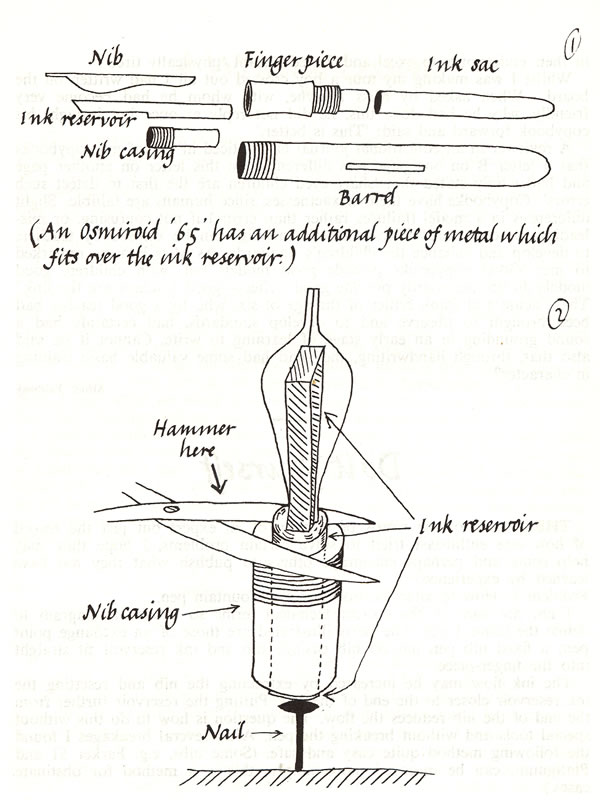Do It Yourself
How to solve problems with your writing implement
By Simon Trafford, OSB
Date Added: 18/07/2009
Article
THESE are not the words of wisdom of an expert but just the record of how one enthusiast tried to solve certain problems. I hope they may help some and perhaps encourage others to publish what they too have learned by experience.
Problem 1: How to alter the ink flow of a fountain pen.
I am not sure of the correct technical terms so I offer a diagram to define the terms I use. The parts illustrated are those of an exchange point pen; a fixed nib pen has no nib casIng-nib and ink reservoir fit straight into the finger-piece.
The ink flow may be increased by extracting the nib and resetting the ink reservoir closer to the end of the nib. Putting the reservoir further from the end of the nib reduces the flow. The question is how to do this without special tools and without breaking the pen. After several breakages I found the following method quite easy and safe. (Some nibs. e.g. Parker 51 and Platignum. can be removed more simply; this is a method for obstinate cases.)
Empty and clean the pen and remove the nib casing containing nib and reservoir (or with a fixed nib pen remove fingerpiece and take off the sac; this is quite easy and does not damage it and it can be replaced afterwards.) Hammer an inch nail with a flat head into a piece of wood and place the nib unit on top so that the back of the reservoir is resting on the nail. If one now pushes the nib casing (or fingerpiece) down, nib and ink reservoir will be pushed up and out. To do this I found that if one places the blades of a partly open pair of scissors on top of the nib casing on either side of the nib and taps the scissors gently but firmly with a hammer, nib and reservoir come out easily.
Before resetting and reassembling, the parts must be clean and dry. Holding nib and reservoir in a cloth to give a better grip, push them back into the nib casing (or fingerpiece) and the job is complete.

Problem 2: How to make black ink really black.
I noticed that a new bottle of Waterman's Calligraph ink was much less black than a nearly empty one. I assumed therefore that the ink evaporates and gradually becomes blacker. So I tried to accelerate the process by putting 'a small amount in a fairly wide bottle. After a week it was very much blacker. I had one bottle several months old which I used extensively for formal lettering because it was blacker than any other black ink I could find and still very easy flowing (but Waterman's has the disadvantage that it is liable to smudge on smooth paper). I have no doubt that the evaporation could be carried out much more quickly in an open dish but have not tried this yet myself. Perhaps it is worth saying that ink does not make a really black mark if the flow is insufficient; in other words, for those who do not obtain good results it may be the pen rather than the ink which is at fault and what is necessary is the increase of flow as described above.
